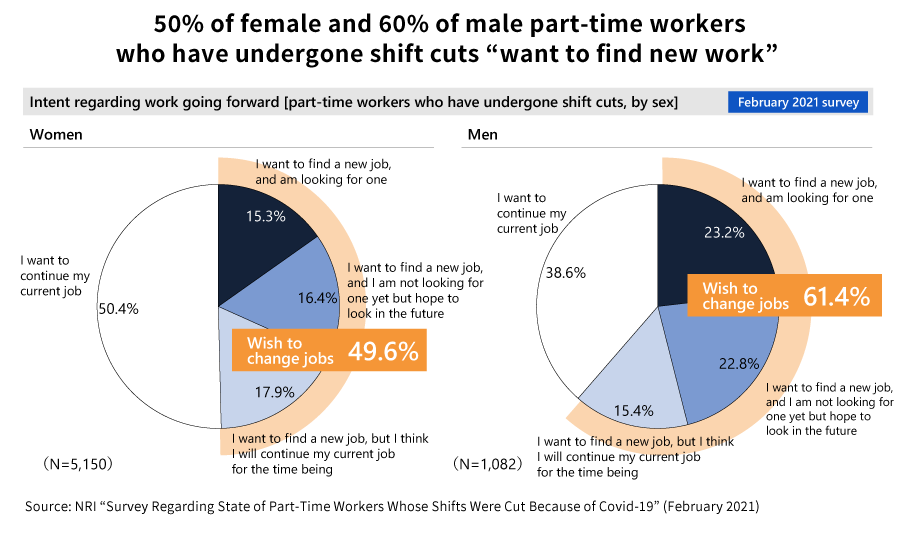
Why Assistance Is Not Reaching People Who Are “Substantially Out of Work” --Challenges and Solutions
In February 2021, the Nomura Research Institute (NRI) conducted an internet survey of 64,943 part-time employees around Japan and 6,232 of such employees whose work hours were cut as a result of the spread of Covid-19.
We asked Shinichiro Umeya and Kana Takeda, who have been continually involved in research and analysis of people who are “substantially out of work” and conducted this survey, about the state of those “substantially out of work” whose work hours have been cut and who are not receiving any allowances, the reasons why public assistance is not reaching these people, and the kind of employment policy we need to see put in place.
1.03 million female and 430 thousand male part-time employees are “substantially out of work”
An estimate based on the results of the present survey and data from the Ministry of Internal Affairs and Communications’ “Labor Force Survey” reveals that as of February 2021, 30% of female part-time workers saw their shifts reduced as a result of the spread of Covid-19 infection, and more than 40% of these workers saw their shifts reduced by 50% or more compared to before Covid-19. Meanwhile, more than 30% of male part-time workers saw their shifts reduced, and roughly 50% of these workers saw their shifts reduced by 50% or more compared to before Covid-19.
Further, the reality that more than 70% of female part-time workers whose shifts were cut are not receiving leave allowances has not changed since the time of our December 2020 survey, and the present survey newly revealed that 80% of male part-time workers whose shifts were cut are not receiving leave allowances.
It is estimated that as of February 2021, there are 1.031 million female and 434 thousand male part-time workers who are “substantially out of work” 1 . Since the number of female part-time workers “substantially out of work” as of December 2020 was 900 thousand, it was revealed that those “substantially out of work” increased more than 10% in approximately two months.
- 1 People who are substantially out of work: People “whose shifts were cut by 50% or more” and “who are not receiving leave allowances” are defined as being “substantially out of work”.
Roughly half of those “substantially out of work” do not know about “leave allowances” or “leave assistance”
The survey revealed that roughly half of part-time workers who are “substantially out of work” are entirely unaware that “it is possible to receive leave allowances even in the case of reduced shifts” and about the “support fund and allowance for the leave forced to be taken under the COVID-19 outbreak”.
Of those “substantially out of work” who were unaware of the leave assistance, 40% of women and nearly 50% of men responded that they “would like to receive leave assistance as soon as possible”.
In response to the question about “measures you think would be most effective to promote use of the assistance system”, more than 20% of women responded that “push-type” assistance in which “applicable assistance is provided to people and households satisfying the conditions, even if they do not apply for it” would be effective, and more than 20% of men gave the response of “national and local governments more proactively advertising the fact that there is an assistance system that can be used”.
Further, while many people responded that “television news”, “television information programs and talk shows”, and “internet news” would be effective to inform people of the assistance system, around 50% of women responded that “guidance and notification from one’s workplace” would be effective.
Roughly half of part-time workers whose shifts have been cut wish to change jobs
One in two part-time workers whose shifts have been cut because of Covid-19 would prefer to actually work and receive wages than to receive leave allowances or leave assistance. The most commonly given reason, standing at over 50% for both men and women, was “because I don’t know how long I will be able to receive leave allowances or leave assistance”.

Of part-time workers, 50% of women and 60% of men responded that they “wish to find a new job”. Of those, more than 20% of women and 20% of men said that they “wish to change to a job in a different field”. If answers of “either” or “I would prefer to stay in the same type of job as now, but a job of a different type is also acceptable” are added to these, the number of workers wishing or willing to change to a type of job different from the one they are currently employed in is high, at 80% for women and nearly 80% for men.
Challenges are spreading awareness of assistance measures, providing financial assistance by promoting their use, and assisting labor mobility
The present survey revealed that female part-time workers whose shifts were cut and whose income fell because of the spread of Covid-19 have further increased since the end of 2020, and also revealed the conditions being experienced by male part-time workers. The Ministry of Health, Labor and Welfare is proactively conveying to companies that part-time workers are also eligible for leave allowances and leave assistance, but it has been discovered that information about assistance has not reached those who need it.
Although many who are “substantially out of work” want assistance by way of leave assistance and job change assistance, the fact that financial assistance such as “leave allowance” and “leave assistance” is not reaching these people remains a challenge. What is needed first is reliable reach to those people who need assistance. Specifically, it is necessary to provide assistance information through employers and to provide information through message applications and SNS by which information can be delivered directly by a push notification, as well as through media such as private websites that people who are “substantially out of work” are using for job hunting.
It is expected that more time is needed before we reach the end of the Covid-19 pandemic, and the employment environment in fields and job types employing many part-time workers is likely to remain in straitened conditions. It is crucial to promote awareness and use of various assistance measures and to provide swift financial assistance to part-time workers facing adversity as a result. Further, we urgently need to see the expansion of assistance measures promoting labor mobility, that is, job change, so that people wishing to change jobs can earn a working income at a new location to rebuild and maintain their livelihoods. In addition to benefiting the recipients of the assistance, this measure will also prevent worsening of economic and social conditions.
Profile
-
Shinichiro Umeya
-
Kana Takeda
* Organization names and job titles may differ from the current version.